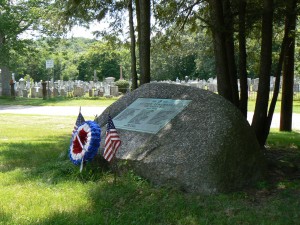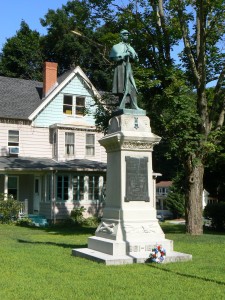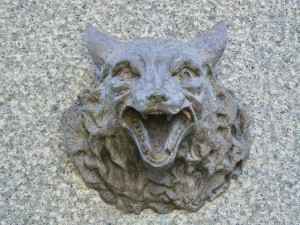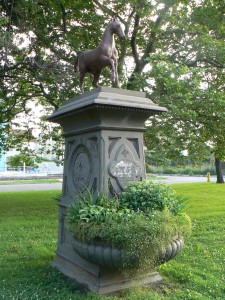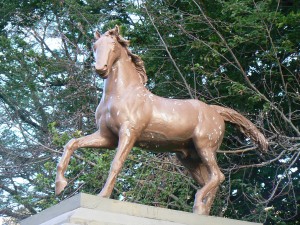 A granite infantry soldier stands atop a Civil War monument on Clinton’s Liberty Green.
A granite infantry soldier stands atop a Civil War monument on Clinton’s Liberty Green.
The monument, dedicated in 1911, features the soldier and a granite base with curved sides that narrows toward the figure. A bronze plaque on the front (south) face reads “Erected by the Woman’s Relief Corps and the citizens of Clinton in memory of the soldiers and sailors who fought to preserve the Union 1861 – 1865 For the dead a tribute, for the living a memory, for posterity an emblem of loyalty to the flag of their country”
Other than the plaque, the monument bears no writing. A state of Connecticut seal appears on the monument’s north face. The figure has growth on his left arm and his right side, along the line between him and his rifle.
The monument is surrounded by a chain supported by four stone pillars, and a cannon used in the War of 1812 stands alongside the monument.
The Woman’s Relief Corps was an auxiliary of the Grand Army of the Republic, and was also responsible for the Soldiers’ Monument in Putnam. The WRC’s involvement and the relatively late dedication date may reflect the women taking action after waiting 40 years for the town’s male veterans to build a monument.
 About three-tenths of a mile west along East Main Street (Route 1), a monument in front of Town Hall honors those who served in other wars. The central panel on the front (north) face lists 10 residents who were killed in the two World Wars and Korea. The two side panels list those who served in the World Wars, and the three panels on the monument’s south face lists residents who served in the nation’s other wars.
About three-tenths of a mile west along East Main Street (Route 1), a monument in front of Town Hall honors those who served in other wars. The central panel on the front (north) face lists 10 residents who were killed in the two World Wars and Korea. The two side panels list those who served in the World Wars, and the three panels on the monument’s south face lists residents who served in the nation’s other wars.
Source:
Connecticut Historical Society: Civil War Monuments of Connecticut
Tags: Clinton
 Good news for Connecticut historic monument fans who own Kindles…we’ve been added to Amazon’s Kindle Blogs Store. That means that three times a week, you can have our latest update sent directly to your Kindle device.
Good news for Connecticut historic monument fans who own Kindles…we’ve been added to Amazon’s Kindle Blogs Store. That means that three times a week, you can have our latest update sent directly to your Kindle device.
Here’s more info about subscribing.
If you’d rather see the state’s historic monuments and sites documented in full-color glory, we’ll still be right here. Tomorrow the fun resumes with a look at the Soliders’ and Sailors’ Monument in Clinton, CT. See you then.
 The Town of Orleans, Mass., honors its Civil War veterans with two monuments along Main Street.
The Town of Orleans, Mass., honors its Civil War veterans with two monuments along Main Street.
At the corner of Main Street and Monument Road stands an 1883 monument depicting an infantry officer standing atop a granite base. While the monument’s appearance resembles many traditional Civil War monuments, the Orleans monument is uncommon because the figure is made of zinc instead of the more typical choices of granite or bronze.
The dedication on the front (west) face of the monument reads “Erected by the Town of Orleans to the memory of those who died that their country might live 1861-1865.”
The west face also features a decorative element depicting flags, cannon balls and a drum that, like the infantry figure, is made of zinc.
The north and south faces of the monument both list the names of four residents who were killed in the war, while the east face is blank.
 Less than two-tenths of a mile east along Main Street stands a boulder with an undated bronze plaque that also honors local Civil War veterans. A dedication on the north face of the monument reads “A grateful tribute to the men of Orleans who served in the Army and Navy in the Civil War.”
Less than two-tenths of a mile east along Main Street stands a boulder with an undated bronze plaque that also honors local Civil War veterans. A dedication on the north face of the monument reads “A grateful tribute to the men of Orleans who served in the Army and Navy in the Civil War.”
The monument lists the names of 22 residents who served in the Army, 12 who served in the Navy, and four who served in both. One person (Joseph Moody) is listed among the dead on one monument, but is not listed among those who served. Such inconsistencies are not unheard of, given the difficulty many towns had in assembling service rosters after the war.
 Zinc monuments, which were produced primarily by the Monumental Bronze Co. of Bridgeport, CT, in the late 19th and early 20th centuries, were marketed as “white bronze.” Today, zinc monuments can be spotted in older cemeteries by their distinctive pewter-like color. While zinc resists wearing better than stone, it can become brittle, which makes the material better suited for headstone-sized monuments than large Civil War monuments.
Zinc monuments, which were produced primarily by the Monumental Bronze Co. of Bridgeport, CT, in the late 19th and early 20th centuries, were marketed as “white bronze.” Today, zinc monuments can be spotted in older cemeteries by their distinctive pewter-like color. While zinc resists wearing better than stone, it can become brittle, which makes the material better suited for headstone-sized monuments than large Civil War monuments.
Most large zinc Civil War monuments, including examples in Stratford, CT, Gettysburg and two towns in New Hampshire, have required structural repairs.
Tags: Massachusetts
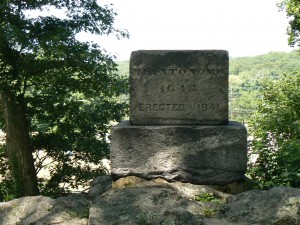 A monument in Norwich’s Sachem Park marks the execution and burial spot of Narragansett chief Miantonimo.
A monument in Norwich’s Sachem Park marks the execution and burial spot of Narragansett chief Miantonimo.
The monument was erected in 1841 to mark the hilltop where Miantonimo was killed in 1643 after years of fighting with Mohegans and English settlers. The site had been marked with a stone cairn. Years later, when the conflicts between English settlers and Native Americans were all but forgotten, the stones marking the gravesite were incorporated into the foundation of a farmhouse.
Today, the monument sits on the top of the hill in a small park along Norwich’s Elijah Street. The site is well-marked with directional signs on Boswell Avenue (Route 12), and a historical marker (one of many excellent markers in Norwich) explains the significance of the site and the monument.
 The town of Easton honors veterans of the World Wars and Korea with bronze plaques mounted on stone bases in two locations.
The town of Easton honors veterans of the World Wars and Korea with bronze plaques mounted on stone bases in two locations.
Veterans of World War II and Korea are honored with a large monument outside Town Hall on Center Road. A dedication on the front (northwest) face of the undated monument reads “Lest we forget / In memory of the Easton veterans of World War II and Korea.” A larger plaque bears about 212 names, with seven indicating they were killed in one of the conflicts. Both plaques have been mounted on a large, unfinished granite block.
The site is also decorated with two stone planters and a lamppost that’s in danger of being swallowed by the surrounding shrubbery.
 The town’s World War I veterans are honored with a large bronze plaque mounted on a boulder along Stepney Road (Route 59). The plaque bears the dedication “Easton remembers the Great War” above three columns listing 34 names of local residents who served in the war. One resident who was killed in the conflict is listed separately under the heading “the fallen.”
The town’s World War I veterans are honored with a large bronze plaque mounted on a boulder along Stepney Road (Route 59). The plaque bears the dedication “Easton remembers the Great War” above three columns listing 34 names of local residents who served in the war. One resident who was killed in the conflict is listed separately under the heading “the fallen.”
The boulder sits outside Union Cemetery, which dates back to the 17th Century. The cemetery is reportedly haunted by a ghost known as “White Lady,” and local police keep a close eye on the grounds to discourage nocturnal ghost-hunting.
Tags: Easton
 Thompson has honored veterans of the Civil War, the Spanish-American War and the American Revolution with plaques affixed to boulders in two sections of town.
Thompson has honored veterans of the Civil War, the Spanish-American War and the American Revolution with plaques affixed to boulders in two sections of town.
Civil War and Spanish-American War veterans are honored with a plaque on the Thompson Common along Route 193 (Thompson Road). The front (east) face of the plaque bears the inscription “Dedicated by the Town of Thompson to honor its soldiers of the Civil and Spanish Wars.”
The monument lists approximately 235 Civil War veterans as well as eight who served in the Spanish-American War. The monument also carries a catch-all dedication reading “This monument honors equally any soldier whose name has been unintentionally omitted.”
 The plaque is not dated, and information about its dedication has not been recorded.
The plaque is not dated, and information about its dedication has not been recorded.
In West Thompson Cemetery, also along Route 193, a monument was dedicated in 1916 to honor the 40 veterans of the American Revolution who are buried in the cemetery. A plaque, affixed to a boulder, lists the veterans and the ranks of officers.
Both monuments have flagpoles nearby.
Source:
Connecticut Historical Society: Civil War Monuments of Connecticut
Tags: Thompson
 Putnam honors local Civil War veterans with a monument in a small park at the corner of Grove Street (Route 12) and Ring Street.
Putnam honors local Civil War veterans with a monument in a small park at the corner of Grove Street (Route 12) and Ring Street.
The dedication on the monument’s front (east) face reads “To the memory of the soldiers and sailors of Putnam and vicinity who fought for the preservation of the Union 1861 – 1865.”
The bottom of the base is also stamped with the years of the Civil War, and a bronze Grand Army of the Republic medal appears just below the infantryman’s feet.
The base of the north and south faces features raised cannons symbolizing artillery units, and the west face features crossed rifles to honor the infantry. Other than the plaque on the front face, the monument does not have additional lettering.
The monument was erected in 1912 by the A.G Warner chapter of the Woman’s Relief Corps. The Relief Corps was an auxiliary organization of the Grand Army of the Republic, the Union veterans’ organization formed after the Civil War.
 The Putnam chapter was named after Addison G. Lawrence, a cavalry officer who was killed in Virginia in 1864.
The Putnam chapter was named after Addison G. Lawrence, a cavalry officer who was killed in Virginia in 1864.
A flagpole stands in front of the monument. A tree visible when the Connecticut Historical Society photographed the monument in the early-to-mid 1990s has been removed.
Source:
Connecticut Historical Society: Civil War Monuments of Connecticut
Tags: Putnam
 Brooklyn has honored the memory of local Civil War veterans with a Canterbury Road monument featuring an infantry officer standing atop a granite pillar.
Brooklyn has honored the memory of local Civil War veterans with a Canterbury Road monument featuring an infantry officer standing atop a granite pillar.
The monument, dedicated in 1888, was designed by sculptor Karl Gerhardt, who was also responsible for the nearby monument honoring American Revolution hero Israel Putnam.
The front (east) face of the Civil War monument bears a dedication “To the memory of all the brave men of Brooklyn who fought on land or sea for the preservation of the Union.” The east face also lists the battles of Antietam and Gettysburg.
The rear (west) face of the monument bears a bronze plaque listing the names of approximately 165 residents who served in the conflict, and also lists the battles of Winchester and Drury’s Bluff (Virginia).
The north face lists battles in New Berne (N.C.) and Cold Harbor (Va.), and the south face lists the battles of Petersburg and Cedar Creek (Va).
Bronze decorative elements on the monument include the Connecticut state seal as well as emblems honoring artillery and naval units.
 The monument was donated to Brooklyn by Thomas S. Marlor, a English native and successful financier who retired to the town in 1869. Marlor also donated the site of the Putnam monument, which was funded by the state.
The monument was donated to Brooklyn by Thomas S. Marlor, a English native and successful financier who retired to the town in 1869. Marlor also donated the site of the Putnam monument, which was funded by the state.
An 1863 Parrott Rifle cannon has been mounted on a brick base next to the monument. The cannon’s barrel is free of litter, and contains only a wasp or hornet nest that we declined to explore further.
Just north of the Civil War and Putnam monuments, Brooklyn has erected a monument to the residents who served in World War II, Korea and Vietnam. The World War II monument features five granite panels listing the residents who served, as honoring seven who died in the conflict. Separate panels, dedicated in 2000, honor the service of local residents in Korea and Vietnam.
 A bit further north on Canterbury Road, a plaque on a boulder honors the residents who served in World War I. The plaque contains about 72 names, and honors three residents who died in the war.
A bit further north on Canterbury Road, a plaque on a boulder honors the residents who served in World War I. The plaque contains about 72 names, and honors three residents who died in the war.
Source:
Connecticut Historical Society: Civil War Monuments of Connecticut
Tags: Brooklyn
 Revolutionary War hero Israel Putnam is honored with an equestrian monument at his burial site on Canterbury Road (Route 169) in Brooklyn, CT.
Revolutionary War hero Israel Putnam is honored with an equestrian monument at his burial site on Canterbury Road (Route 169) in Brooklyn, CT.
The monument was dedicated in 1888 to honor Putnam, a Massachusetts native who served with distinction during the French and Indian War and who later abandoned his plow in the field to join the Continental Army when the American Revolution began.
Putnam is depicted directing troops on horseback. His horse faces east, and Putnam is looking toward the north. Large granite slabs on the north and south faces bear biographical and inspirational messages that were inscribed on Putnam’s original headstone.
 The wolves on the east and west faces refer to an incident in which Putnam ventured into a cave to kill a wolf that was helping herself to local farmer’ sheep.
The wolves on the east and west faces refer to an incident in which Putnam ventured into a cave to kill a wolf that was helping herself to local farmer’ sheep.
Upon his death in 1790, Putnam was buried in an aboveground tomb in Brooklyn’s South Cemetery. Over the years, souvenir hunters had removed fragments of the headstone and the overall condition of the tomb was deemed unsuitable for General Putnam.
Sculptor Karl Gerhardt, also responsible for the nearby Soldiers’ and Sailors’ Monument as well as Civil War monuments in New York and New Jersey, was chosen to create a monument that would provide a new home for Putnam’s remains. Putnam was placed in a sarcophagus in the base, and the original headstone inscription was recreated on the monument. (The original headstone was put on display in the state capitol.)
The vintage postcard appearing below was postmarked in 1907. The yellow building next to the monument has since been replaced by a Post Office.
North of the monument, a plaque on a boulder marks the site of Putnam’s Brooklyn farm and tavern.
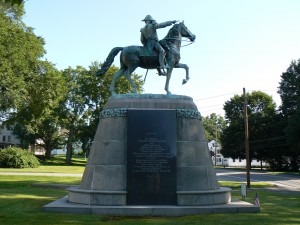 Putnam commanded Continental forces during the Battle of Bunker Hill in 1775, and may have issued the famous command not to fire until troops saw the white of the British soldiers’ eyes. Putnam was forced to retreat from New York during the 1776 Battle of Long Island.
Putnam commanded Continental forces during the Battle of Bunker Hill in 1775, and may have issued the famous command not to fire until troops saw the white of the British soldiers’ eyes. Putnam was forced to retreat from New York during the 1776 Battle of Long Island.
Putnam’s military career was ended by a stroke in 1779, while the general and the Connecticut militia was in winter camp in Redding. The encampment site is now Putnam State Park.
Putnam was also honored with statues in the state park and Hartford’s Bushnell Park. The town of Putnam, just north of Brooklyn, was named after him, as were eight counties.
Tags: Brooklyn
 The founder of the American Society for the Prevention of Cruelty to Animals was honored with a monument in Bridgeport’s Seaside Park thanks to showman and former mayor P.T. Barnum.
The founder of the American Society for the Prevention of Cruelty to Animals was honored with a monument in Bridgeport’s Seaside Park thanks to showman and former mayor P.T. Barnum.
The monument, a fountain that was later converted into a planter, was dedicated in 1897 to honor Henry Bergh’s lifelong efforts to protect animals. Bergh is honored with a dedication on the front (south) side, above what used to be one of the fountain’s two water troughs. Images on the east and west side depict an allegorical angel rescuing a horse from being struck.
The monument is topped by a plaster horse that is a replacement for a similar horse that, according to a 1967 profile of Bergh in American Heritage, was damaged when the monument was struck by a car in 1964.
Bergh founded the ASPCA in 1866 after seeing a similar organization during a visit to London. Returning to New York City, Bergh found the ASPCA and began advocating for the fair treatment of animals such as the horses who pulled carts and the livestock that were slaughtered in the city.
 Bergh also devoted attention to protecting the animals used in Barnum’s circus performances. Although Barnum initially considered Bergh a pain, the two men developed a mutual respect that eventually grew into a friendship. Upon Barnum’s death, he willed funds for a fountain to be built in Bridgeport to honor his friend.
Bergh also devoted attention to protecting the animals used in Barnum’s circus performances. Although Barnum initially considered Bergh a pain, the two men developed a mutual respect that eventually grew into a friendship. Upon Barnum’s death, he willed funds for a fountain to be built in Bridgeport to honor his friend.
Tags: Bridgeport












